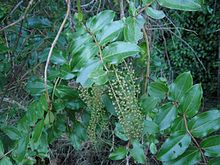Coriaria arborea
| Coriaria arborea | |
|---|---|

| |
| Scientific classification | |
| Kingdom: | Plantae |
| Clade: | Tracheophytes |
| Clade: | Angiosperms |
| Clade: | Eudicots |
| Clade: | Rosids |
| Order: | Cucurbitales |
| Family: | Coriariaceae |
| Genus: | Coriaria |
| Species: | C. arborea
|
| Binomial name | |
| Coriaria arborea | |
Coriaria arborea is a highly poisonous and common native shrub or small tree of New Zealand. The common name for this and the other New Zealand species of Coriaria is tutu.
Coriaria arborea is found in
Ecology
C. arborea plays host to several species of New Zealand endemic moth including Izatha austera, I. churtoni, I. mesoschista and I. peroneanella.[3]
Uses
In spite of its toxicity, Tutu was consumed by
Toxicity
The toxin
In 2014, a man
Honey becomes contaminated when bees collect honeydew secreted by the passionvine hopper insect that feeds off the tutu plant.[8] People have occasionally been hospitalised or even killed by honey contaminated with tutin. 1974 was the last case of commercial honey poisoning where 13 people were poisoned. Since 1974 there have been nine other cases of honey poisoning, with the most recent occurring in 1991 in the Bay of Plenty and 2008 in the Coromandel.[9] Periods of drought increase the risk of poisoning.

References
- ^ "Tutu (Coriaria arborea)". Taranaki Educational Resource: Research, Analysis and Information Network. Retrieved 22 May 2012.
- S2CID 4146694.
- ^ Bennik, Rebecca Marie (2014). Sexual conflict and genital evolution in moths (PDF) (Thesis). University of Auckland. Retrieved 28 April 2018.
- ^ "Uses of Coriaria arborea- Tutu". Retrieved 3 June 2019.
- ^ "Diseases of sheep, cattle and deer - Tutu". Te Ara - the Encyclopedia of New Zealand. 24 November 2008. Retrieved 31 August 2015.
- ^ Poole, Alec Lindsay (1966). "Tutu". An Encyclopaedia of New Zealand. Retrieved 18 August 2018.
- ^ "New Zealand's poisonous plants". Radio New Zealand. Retrieved 31 August 2015.
- ^ Johnston, Martin (29 April 2008). "Drought, tutu poisons honey". The New Zealand Herald. Retrieved 31 August 2015.
- ^ "Coriaria arborea var. arborea". New Zealand Plant Conservation Network. Retrieved 31 August 2015.
